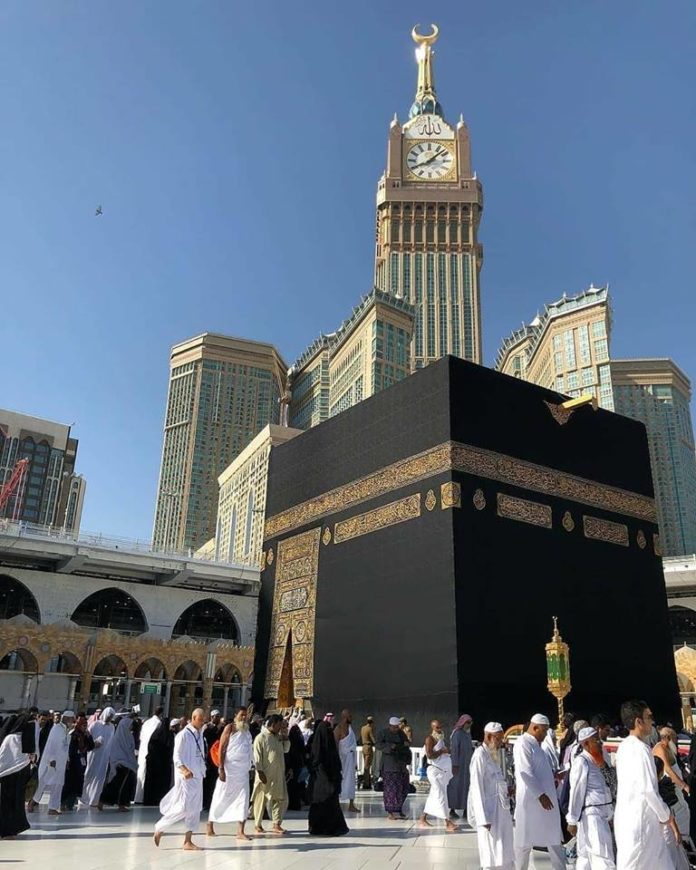
At the outbreak of the Coronavirus, the prospect of hajj 2020 taking place was so slim that any analysis about how coronavirus may shape hajj 2020 will seems like a vague argumentative essay. The situation becomes gloomy when the Kingdom of Saudi Arabia suspends Umrah, halt international and domestic flights and close the two Holy mosques. It was followed by 24-hour curfew amid rising cases of coronavirus in the Holly City of Makkah. Covid-19 or whatever it called itself has continued to ravage the world and shutting down all human activities.
Hope was restored and clouds formation of hajj exercise shows signs of rainfall after the Saudi Ministry of Hajj and Umrah promised to open the two Holy mosques for believers in the coming days. The President of the Two Holy Mosque Sheikh Abdul Rahman Al Sudais also hinted that ‘the Kingdom will once again become the centre of religious activities for Muslim Ummah from all over the world”. The interpretative meaning of “Muslim Ummah from all over the world’ can only mean hajj or Umrah pilgrims arriving in the Kingdom for either Hajj or Umrah.
You know, hope is like a projecting bay window, Martin Luther King Jr once said that “We must accept finite disappointment, but never lose infinite hope.” Hope is alive.
It will be recalled that Minister of Hajj and Umrah said the final decision on hajj 2020 will come to be made by mid-Ramadan. The clock is ticking.
Given the above, one can cautiously predict that there will be hajj this year. However, there is going to be a significant modification of the existing pilgrims’ service guidelines at least within hajj 2020 and 2021. The hajj service delivery protocol will have to change to align with the social distance measures brought by coronavirus as currently being observed in the Grand Mosque in Makkah.
Another factor that may favour this projection is the dwindling oil revenue and a plummeting tourism sector of the Kingdom. The Saudi Vision 2030 projects are anchored on the booming tourism sector and it will be strategically damaging if such ambitions projects enter hibernation due to coronavirus.
More importantly, Saudi Minister of Finance Mohammed Al-Jadaan in an interview with Al Arabiya TV “warns of strict, painful measures to overcome economic challenges” The Minister said “the economic challenges of the coronavirus pandemic are great and neither Saudi Arabia nor the world will be the same when it is over. He then said Saudi Arabia would take “strict and painful measures to deal with the impact, and “all options for dealing with the crisis are open,” This is another indication that hajj and Umrah option may not be excluded.
More importantly, hajj 2020 will come with some condition and one of such is the reduction of the number of pilgrims that will participate in hajj from outside gulf regions. Pilgrims’ quota for hajj participating countries may be reduced to 10 or 50 percent with new health certifications policies. Last year, about 2.5 million pilgrims, three-quarters of whom (almost two million) are foreign visitors. The formula used to allocates quota is based on a quota of 0.1 per cent or one pilgrim per 1,000 Muslims in that country.
While 50 percent allocation (42, 500 of 95, 000 allocations to Nigeria) will be within the limit of the number of pilgrims from Nigeria in the last two years; 10 percent allocations will pose serious distribution and logistics problems for Nigeria. What will be the distribution ratio to states? How many will be given to private tour operators? If the current number of registered pilgrims is above the 10 percent, then how do we select the beneficiary of the 10 percent?. Operational dilemma.
Back to the subject matter. Also, pilgrims may be asked to undergo coronavirus test as a precondition for the issuance of visa or an on spot Covid 19 test will be required before undergoing immigration clearance on arrival at the Kingdom.
Last week, Saudi Arabia signs SR995 million contracts with China to test 9 million people. The contract is one of the largest contracts that will provide diagnostic tests for the novel coronavirus. The contract includes providing necessary equipment and supplies, making available of 500 Chinese specialists and technicians who are specialised in performing tests, establishing six large regional laboratories throughout the Kingdom; including a mobile laboratory with a capacity of performing 10,000 tests per day. Saudi cadres will also be trained to conduct daily tests and comprehensive field tests, under the new agreement. The contract will ensure that a minimum of 9 million people is tested.
Now, “a mobile laboratory with a capacity of performing 10,000 tests per day and the issue of training Saudi cadre to conduct daily tests and comprehensive field tests fitted into coronavirus hajj plan.
Medical services during hajj and umrah will be of high priority if hajj 2020 takes place. Before the outbreak of coronavirus, the Saudi Hajj Ministry had announced health insurance policy for pilgrims which according to them come as part of the Vision 2030 reform plan. Hajj and Umrah Minister Mohammad Saleh bin Taher Benten and Tawuniya Chairman Sulaiman Al-Humaid signed an agreement to provide insurance for pilgrims coming from outside Saudi Arabia. As part of the agreement, the ministry will provide health and other insurance services to pilgrims from the time they arrive in the Kingdom until they leave.
The insurance will be linked to the visa as soon as the pilgrim arrives in Saudi Arabia. Each insurance covers an amount of SR100,000 ($26,665) per person. With the signing of SR995 million contracts with China, the insurance cost may get an upward review.
However, there will be a modification in the area of how hajj services will be delivered. Saudi Arabia may likely tailor future hajj policies in conformity with the coronavirus precautionary measures. Such new policies will alter the current arrangement in the underlisted areas of hajj services: Pilgrims movements which include airlifts and local transportations within Saudi Arabia; Pilgrims accommodations arrangements in Makkah and Madina, Staying in Mina, Muzdalifa and Arafat, and praying or performing tawaf in the Grand Mosque in Makkah.
Now, let’s do a little projective analysis on these vital areas of hajj operations.
Transportation of Pilgrims within Saudi Arabia
The Car Syndicate services will comes with a new system of transporting pilgrims that tally with the 6 feet social distance – the new normal. Something like one passenger seat space between two pilgrims
Pilgrims buses may not be allowed to carry more than 24 pilgrims instead of 48 pilgrims per bus. This measure will increase the number of buses to be used by each country and the number of round trips. An increase in the number of buses and trips also mean an additional cost.
Saudi Car syndicates services are responsible for transporting pilgrims from Madina to Makkah or in reverse order. Transporting pilgrims from Makkah to Mina, Muzdallifah and Arafat and back to Makkah. The implication of this policy may mean additional cost because of an increase in the number of buses and the number of trips.
Airlift of Pilgrims
Before I proceed, one of the airlines announced last week that they will adopt a new sitting arrangement to allow one seat distance between two people. Boeing 747 aircraft can airlift over 500 pilgrims during hajj airlift. It is my prayer and hopes that the social distance measure will not compel the aviation industry to adopt a system that will compel 550 capacity aircraft to accommodate 300 or 350 pilgrims per flight.
For example, Emirates Airline has started to conduct Rapid COVID-19 Tests for Boarding Passengers – the first airline to roll out such services. The analysis is a blood test with results within 10 minutes. It says its testing could also be used to provide confirmation for Emirates passengers travelling to countries that require COVID-19 test certificates. The testing accompanies other changes on Emirates. Passengers are now required to wear masks throughout boarding and flight. Gone are in-flight magazines, and carry-on luggage isn’t permitted – only small items like handbags and briefcases.
The Saudi Arabia General Authority of Civil Aviation may likely fashion out a similar policy for hajj and Umrah pilgrimage, I am leaving the potential cost and operational implications of this ‘projection’ to the experts.
More importantly, It has been predicted that the global airline industry will burn through $61bn of their cash reserves during the second quarter of this year, according to the latest forecast from its trade body. IATA. Air carriers are facing an “enormous cash problem” and face a net loss of $39bn in the three months to the end of June. IATA also said that the pandemic would slash airline revenues by $250bn this year. The Hajj airline industry will not be immune to this negative backslash.
Now, will the hajj or Umrah airfare remains the same in the face of the global downturn?
Let’s wait and hear.
Pilgrims accommodations
Pilgrims spend an average of 5-10 days in Madina and 25- 30 days in their accommodation in Saudi Arabia. 4 or 5 pilgrims are usually housed in a room during hajj exercise. With this arrangement, it is practically difficult to maintain social distance and Saudi Arabia may issue new accommodation guideline with emphasis on reducing the number of pilgrims in a room to 2 or a maximum of 3 pilgrims.
This measure will affect hajj participating countries in terms of costs of pilgrims accommodation because each country will need more rooms (by implication more hotels) to accommodate their pilgrims.
Mashair activities
This is going to be delicate and challenging. Currently, the space in Mina is not enough to accommodate 1.2 million pilgrims going by the standard tent of accommodating 10 or fewer pilgrims per tent. It is still unclear the kind of model that can be adopted in Mina if pilgrims are subjected to the social distance rule in Mina, Muzdalifa and Arafat this year.
The only alternative might be for pilgrims to sidestep mina (provided it didn’t void the hajj rites) and allow pilgrims to be transported from their accommodation in Makkah to the Arafat in a country by country arrangement. Pilgrims may no longer stay in Muzdalifa rather they will be allowed to pray Maghrib and Isha prayer and proceed to Jamrat. This may also come with a country by country times table arrangement.
Coronavirus seems to have set us a challenge to test our courage and willingness to change; at this moment, there is no point in pretending that nothing has happened or in saying that we are not yet ready. The challenge will not wait. We have enough time to decide whether or not to accept the reality that coronavirus has altered hajj operational structure.
Finally and whether there will be hajj in 2020 or 2021, It is my advice that we should be prepared to align with new hajj policies and kick start a process of having a different template for hajj operations. There should be a flexible back up plan that can be reconfigured to suit the new reality of hajj and Umrah industry.
Muhammed is the National Coordinator, Independent Hajj Reporters















